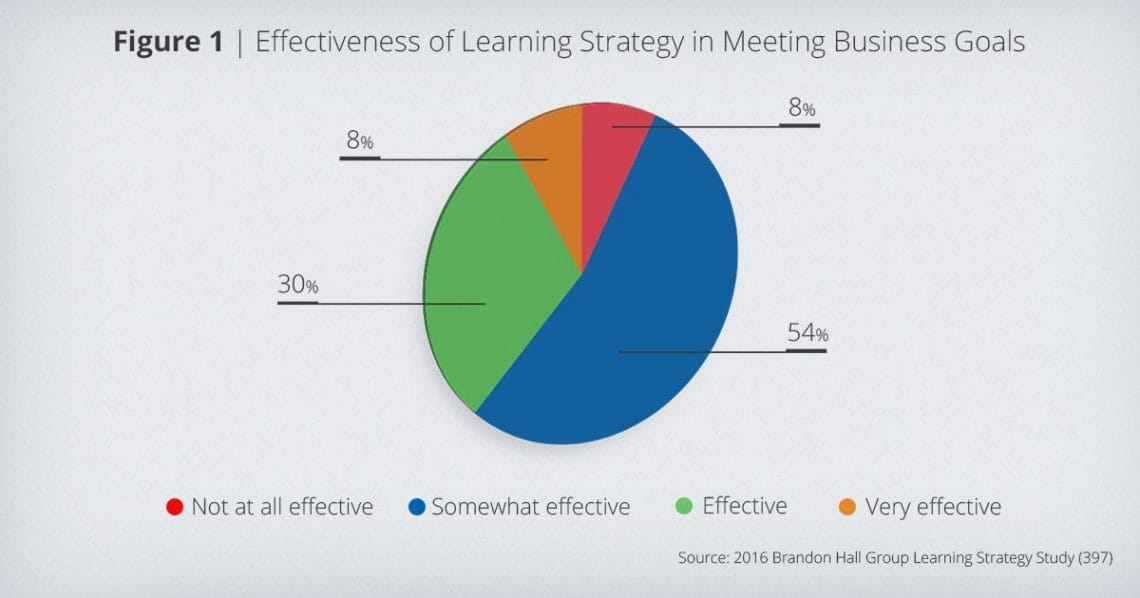
How to harness the power of user-contributed eLearning content: part 1
Are you making the most of your online learners’ experience, knowledge, and skills? Online learners take eLearning courses for a number of reasons, namely to improve their ability to perform their jobs effectively. However, eLearning courses also are an opportunity for learners to share experiences and talents to help their peers improve. To achieve this, eLearning professionals must create a collaborative online learning community fueled by learner contributions.
This is an integral part of a thorough eLearning strategy and, as we learned in the eLearning Trends 2019 Report, an organization’s learning strategy is directly linked to achieving overall business goals. However, as we can see in the chart here, a majority of businesses do not believe their learning and development strategy actually is effective at meeting business goals, and even fewer still leverage user-contributed content.
Below are four tips to help you tap into the power of user-contributed eLearning content. But before we continue, let’s note that there’s a difference between user-contributed content and expert-generated content. The former is any content that is created by new and ongoing learners as they are trained, while the latter is content created by subject-matter experts (SMEs) who may also happen to be users.

1. Repurpose User-Contributed eLearning Content
User-contributed eLearning content is only valuable if you know how to use it. In most cases, this involves repurposing eLearning content to meet the needs of online learners. For example, this can involve inviting online learners to create bite-sized learning modules, and then compiling them into a comprehensive compliance online training course. This allows online learners to take pride of ownership and acknowledges their efforts.
You can even use repurposed eLearning content for future eLearning courses to set an example. Another option is creating an online learner showcase that highlights their best work. Peers are able to view the materials to improve their own comprehension and this also doubles as a collaborative eLearning portfolio that they can expand over time. But be sure to ask for their permission before repurposing user-contributed eLearning content. Some people may not want their work displayed for public viewing.
2. Create A Knowledge-Sharing Hub
We’ve mentioned a variety of online platforms, such as social media sites and group forums. However, your user-contributed eLearning content strategy should include a central hub. This serves as a virtual headquarter for your online learners where they can gather and discuss important topics. It’s also the place where you’ll store the collaborative online resource repository and resource lists. For example, set up an eLearning blog site that features an eLearning course calendar, updates, and essential links. Post on a regular basis and invite online learners to comment or ask questions.
3. Host Live “Guest Host” eLearning Events
Schedule a weekly eLearning event and allow online learners to guest host and allow them to choose a topic that interests them or caters to their strengths. For example, a guest host who has an IT background might share tech tips and troubleshooting advice. The only caveat is that the topic must tie into the learning objectives. The audience is able to ask questions in advance and offer their input. If you’re working with a larger group, assign a few speakers for each eLearning event or host smaller team sessions. You can even encourage the guest hosts to develop complementary eLearning materials. For instance, an eLearning assessment that tests comprehension or an interactive presentation featuring the key takeaways.
4. Facilitate Peer-Based eLearning Feedback
Feedback is one of the most notable benefits that online learners receive from their contributed eLearning content. They invest time and effort into creating eLearning materials. In exchange, they gain peer insights and eLearning experience. Encourage online learners to review the contributed eLearning content and then follow it up with a survey or questionnaire. Alternatively, invite them to leave a comment that highlights the strengths and areas for improvement. Online instructors, managers, and SMEs should have the opportunity to review the feedback and intervene, when necessary. For example, making changes to the eLearning course design or offering supplemental eLearning tools.
Incorporating user-contributed eLearning content into your eLearning strategy offers a range of benefits. It increases learner engagement, motivation, and active participation. With it, learners are no longer passive observers, and they are granted the power to contribute and share their insights. This article can help you create a supportive online learning community where people are free to share their ideas and exchange information.
Do you have the right tools to engage users, leverage user-generated content, and take learning to the next level? Try Docebo free for two weeks to explore a whole new level of eLearning.
